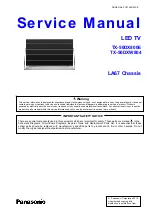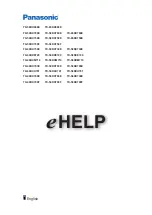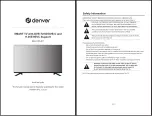
Circuit Descriptions, List of Abbreviations, and IC Data Sheets
EN 75
L04HU AA
9.
9.7.4
Options
The option settings allow for process of the video as per set
specification. The option settings can be found in “Option 2”
and “Option 6” in the SAM mode. The option settings are as
follows:
•
Option Byte 2
–
Bit 7:
–
Bit 6 :OP_GREEN_UI
–
Bit 5: OP_CHANNEL_NAMING,
–
Bit 4: OP_LTI,
–
Bit 3: OP_TILT,
–
Bit 2: OP_FINE_TUNING
–
Bit 1: OP_PIP_PHILIPS_TUNER,
–
Bit 0: OP_HUE,
•
Option Byte 6
–
Bit 7: OP_PERSONAL_ZAPPING,
–
Bit 6:
–
Bit 5: OP_FMTRAP
–
Bit 4: OP_COMBFILTER
–
Bit 3: OP_ACTIVE_CONTROL
–
Bit 2: OP_VIDEO_TEXT
–
Bit 1 :OP_LIGHT_SENSOR,
–
Bit 0: OP_DUAL_TEXT
For more details on the option settings, please refer to the
chapter 8 “Alignments”.
9.8
Audio Processing
The audio decoding is done entirely via the Hercules. The IF
output from the Tuner is fed directly to either the Video-IF or the
Sound-IF input depending on the type of concept chosen.
There are mainly two types of decoder in the Hercules, an
analog decoder that decodes only Mono, regardless of any
standards, and a digital decoder (or DEMDEC) that can decode
both Mono as well as Stereo, again regardless of any
standards.
In this chassis, the analog decoder is used in two cases:
•
It is used for AM Sound demodulation in the Europe
SECAM LL’ transmission.
•
It is used for all FM demodulation in AP AV-Stereo sets.
9.8.1
Diversity
The diversity for the Audio decoding can be broken up into two
main concepts:
•
The Quasi Split Sound concept used in Europe and some
AP sets.
•
The Inter Carrier concept, used in NAFTA and LATAM.
The UOC-III family makes no difference anymore between
QSS- and Intercarrier IF, nearly all types are software-
switchable between the two SAW-filter constructions.
Simple data settings are required for the set to determine
whether it is using the Inter Carrier or the QSS concept. These
settings are done via the “QSS” and “FMI” bit found in SAM
mode. Due to the diversity involved, the data for the 2 bits are
being placed in the NVM location and it is required to write once
during startup.
On top of that, it can be further broken down into various
systems depending on the region. The systems or region
chosen, will in turn affect the type of sound standard that is/are
allowed to be decoded.
•
For the case of
Europe
, the standard consists of BG/DK/I/
LL’ for a Multi-System set. There are also versions of
Eastern Europe and Western Europe set and the standard
for decoding will be BG/DK and I/DK respectively. FM
Radio is a feature diversity for the Europe sets. The same
version can have either FM Radio or not, independent of
the system (e.g. sets with BG/DK/I/LL’ can have or not
have FM radio).
•
For the case of
NAFTA
and
LATAM
, there is only one
transmission standard, which is the M standard. The
diversity then will be based on whether it has a dBx noise
reduction or a Non-dBx (no dBx noise reduction).
•
For the case of
AP
, the standard consists of BG/DK/I/M for
a Multi-System set. The diversity here will then depends on
the region. AP China can have a Multi-System and I/DK
version. For India, it might only be BG standard.
9.8.2
Functionality
The features available in the Hercules are as follows:
•
Treble and Bass Control.
•
Surround Sound Effect that includes:
–
Incredible Stereo.
–
Incredible Mono.
–
3D Sound (not for AV Stereo).
–
TruSurround (not for AV Stereo).
–
Virtual Dolby Surround, VDS422 (not for AV Stereo).
–
Virtual Dolby Surround, VDS423 (not for AV Stereo).
–
Dolby Pro-Logic (not for AV Stereo).
•
Bass Feature that includes:
–
Dynamic Ultra-Bass.
–
Dynamic Bass Enhancement.
–
BBE (not for AV Stereo).
•
Auto-Volume Leveler.
•
5 Band Equalizer.
•
Loudness Control.
All the features stated are available for the Full Stereo versions
and limited features for the AV Stereo
9.9
Audio Amplifier
The audio amplifier part is very straightforward. It uses the
integrated power amplifier TDA2616Q, and delivers a
maximum output of 2 x 10 W_rms.
The maximum operating condition for this amplifier is 21 V
unloaded. Normal operating supply is from 7.5 V to 16 V.
Muting is done via the VOLUME_MUTE line connected to pin
2 of the amplifier-IC and coming from the UOC.
The following table shows pin functionality of the Audio
Amplifier:
Table 9-13 Pinning overview TDA2616
Pin Pin Name
Normal Operation
1
Input Left
Input AC signal
2
Mute
16 V_dc
3
Ground
0 V
4
Output L Channel
AC waveform
5
Supply Voltage (negative)
-16 V_dc
6
Output R Channel
AC waveform
7
Supply Voltage (positive)
+ 16 V_dc
8
Inverting inputs L and R
0 V
9
Input Right
Input AC signal
















































